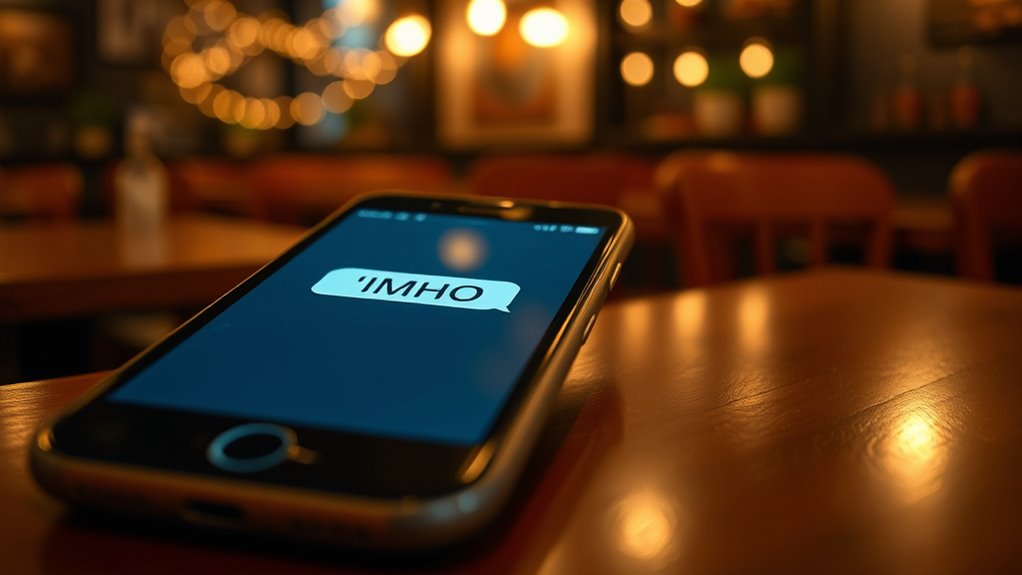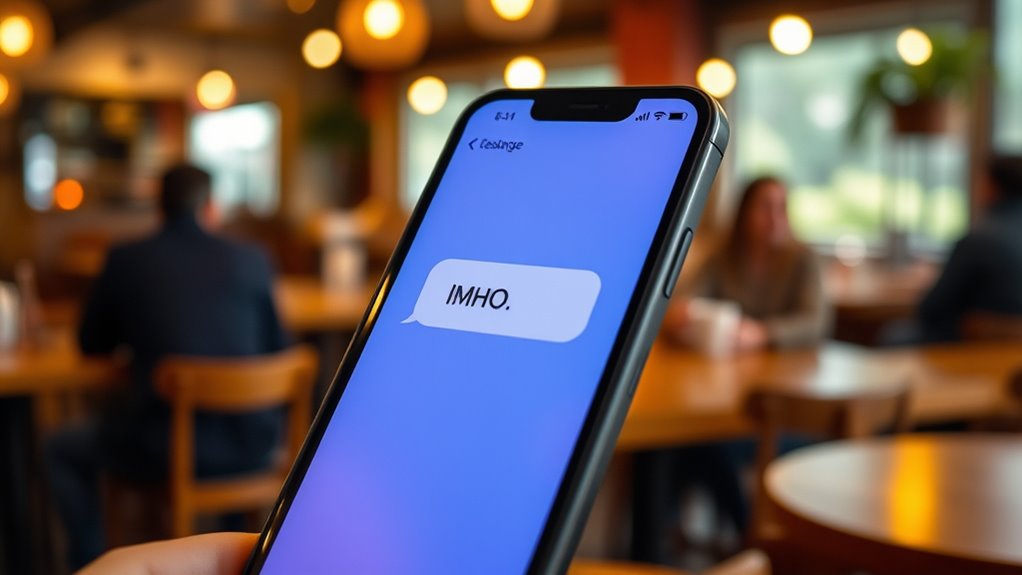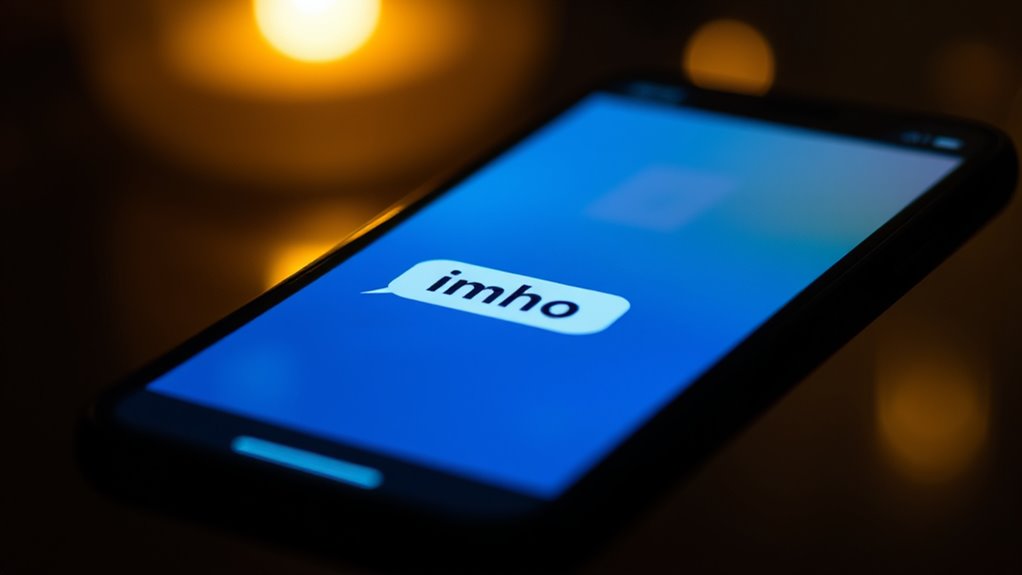If you see “IMHO” in a text, it stands for “In My Honest Opinion” or “In My Humble Opinion.” People use it to share their personal views politely and to soften disagreements in online chats and forums. It helps convey your message clearly while showing humility. To understand more about how and when to use IMHO, along with similar phrases, keep exploring further guidance.
Key Takeaways
- IMHO stands for “In My Honest Opinion” or “In My Humble Opinion.”
- It is used online to politely express personal viewpoints.
- Commonly seen in casual conversations and internet forums.
- It softens disagreements and shows humility in communication.
- Not suitable for formal or professional contexts.
The Origin and Meaning of IMHO

IMHO is an acronym that stands for “In My Honest Opinion” or “In My Humble Opinion,” and it has become popular in online conversations. Historically, its usage dates back to early internet forums and email exchanges, where users wanted to clearly express personal views. Over time, IMHO gained traction across different cultures, often used to soften opinions or show humility, reflecting cultural differences in communication styles. In some regions, it’s seen as a polite way to voice disagreement, while in others, it’s simply a quick way to share an honest perspective. Understanding its origins and cultural variations helps you see why people choose IMHO—it’s a concise way to convey personal judgment with a touch of politeness. Additionally, the use of abbreviations like IMHO is closely related to the evolution of online communication, which favors brevity and efficiency.
How to Use IMHO in Conversations

When you want to express your personal opinion politely in a conversation, incorporating IMHO can be very effective. It allows you to share your thoughts without sounding forceful, making your communication more respectful. In formal settings, using IMHO can help soften disagreements and show humility, but it’s best to keep it subtle. In casual usage, IMHO fits naturally into everyday chats and messages, helping you sound friendly and approachable. Remember, while IMHO signals your opinion, it also indicates you’re open to other perspectives. Use it sparingly to maintain clarity and avoid overusing abbreviations. Whether in professional or casual conversations, knowing how and when to include IMHO can improve your tone and make your opinions feel considerate and balanced. Understanding informal language can enhance your overall communication skills across different contexts.
Variations and Similar Acronyms

Have you noticed that there are several variations and similar acronyms to IMHO used in digital communication? These often appear in casual slang and can sometimes find their way into formal writing, though less commonly. Here are some common ones:
- IMO (In My Opinion) – Similar in meaning, more concise.
- IYKWIM (If You Know What I Mean) – Adds a hint of humor or sarcasm.
- FWIW (For What It’s Worth) – Expresses a personal opinion, often informal.
- IMV (In My View) – Slightly more formal variation of IMHO.
While these acronyms are flexible in casual chats, stick to clearer language in formal contexts to maintain professionalism. Additionally, understanding the city dynamics and local communication styles can help in interpreting these acronyms more effectively.
When to Avoid Using IMHO

Although using IMHO can add a personal touch to your messages, there are times when it’s best to avoid it, especially in formal tone or professional context. Relying on IMHO may undermine your credibility or appear too informal during business communications, reports, or official emails. It’s important to maintain professionalism and clarity, so expressing opinions without abbreviations like IMHO helps convey respect and seriousness. Avoid using IMHO when addressing clients, superiors, or in situations requiring objectivity. Instead, choose precise language that clearly states your perspective without sounding subjective or casual. When clarity and professionalism are priorities, steering clear of IMHO ensures your message is received with the appropriate tone and authority. Additionally, understanding subtopics like professional communication can help you decide when to omit informal abbreviations.
Tips for Clear Digital Communication

Clear digital communication starts with choosing your words carefully and organizing your message logically. To improve your clarity, consider these tips:
- Use proper email etiquette by greeting and closing professionally, which sets a respectful tone.
- Keep your messages concise to avoid confusion and ensure your main point stands out.
- Refine your tone to match the context, whether formal or casual, to prevent misunderstandings.
- Break complex ideas into bullet points or numbered lists for easier reading and comprehension.
- Remember that script optimization and understanding your audience can significantly enhance how your message is received.
Frequently Asked Questions
Can IMHO Be Used in Formal Writing?
You generally shouldn’t use IMHO in formal writing or scholarly contexts because it’s informal and personal. While it’s acceptable in casual texts or emails, maintaining a formal tone requires avoiding abbreviations like IMHO. Instead, express your opinion clearly and professionally, such as “In my opinion” or “From my perspective,” which suit the scholarly context better and uphold the expected formal tone.
What Are Common Mistakes When Using IMHO?
Using IMHO is like steering through a maze; if you’re not careful, you might get lost in tonal confusion. Common mistakes include assuming everyone shares your tone, leading to contextual misunderstandings, or overusing it in serious conversations. Remember, IMHO signals your opinion, so avoid misapplying it in formal or sensitive discussions. Be clear about your intent, and always consider how your tone might be misinterpreted.
Is IMHO Considered Polite or Rude?
IMHO is generally considered polite in online communication and email etiquette, as it signals your personal opinion without sounding confrontational. When you use IMHO, you show respect for differing viewpoints, making your message more courteous. However, tone can be hard to interpret in digital formats, so guarantee your overall message remains respectful. Using IMHO thoughtfully helps maintain positive online interactions and demonstrates good email etiquette.
How Does IMHO Differ From IMO or IME?
Imagine you’re chatting with a colleague online and want to express your personal opinion politely. IMHO, IMO, and IME all serve that purpose, but they differ slightly. IMHO means “In My Humble Opinion,” showing modesty. IMO is “In My Opinion,” more neutral. IME is “In My Experience,” referencing personal knowledge. In email etiquette, choosing the right one helps communicate respect and clarity in online communication.
Are There Cultural Differences in Using IMHO Globally?
You’ll find that cultural communication influences how people use IMHO globally, with some regions embracing it widely, while others prefer more formal expressions. In countries with a strong digital culture, IMHO is common in casual conversations, reflecting global slang usage. However, in more formal settings or cultures valuing politeness, it might be less frequent. So, understanding local norms helps you connect better and avoid misunderstandings in digital communication.
Conclusion
Now that you know what IMHO means and how to use it, you can confidently share your opinions online. Think of IMHO as a gentle breeze—your way to express your thoughts without causing a storm. Just remember to use it thoughtfully, like a spice in a recipe, to keep your message clear and respectful. With this knowledge, your digital conversations will flow smoothly, making your exchanges as invigorating as a clear, sunny day.









